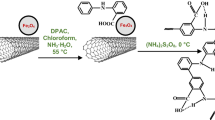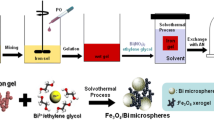Abstract
We herein report a facile approach to the fabrication of core–shell structured magnetic Fe3O4/poly(cyclotriphosphazene-co-4,4′-sulfonyldiphenol) nanocomposite particles via precipitation polymerization of comonomers hexachlorocyclotriphosphazene and 4,4′-sulfonyldiphenol in the presence of Fe3O4 nanopaticles. The morphology, composition, thermal property, and magnetic property of the magnetic nanocomposite particles were characterized by scanning electron microscope, transmission electron microscope, Fourier transform infrared spectra, energy dispersive X-ray spectroscopy, X-ray diffraction, thermogravimetric analysis, and vibrating sample magnetometer, respectively. Results indicated that the submicron-sized magnetic nanocomposite particles own core/shell structures, 410 °C of initial decomposition temperature under an air atmosphere, and 6.2 emu/g of saturation magnetization, which should make them have potential applications in biotechnology and catalyst supports. Furthermore, we also proposed a possible formation mechanism of these magnetic Fe3O4/PZS nanocomposite particles.






Similar content being viewed by others
References
Alsmadi NA, Wadajkar AS, Cui W, Nguyen KT (2011) Effects of surfactants on properties of polymer-coated magnetic nanoparticles for drug delivery application. J Nanopart Res 13:7177–7186
Ckmak S, Gumusderelioglu M, Denizli A (2009) Biofunctionalization of magnetic poly(glycidyl methacrylate) microspheres with protein a: characterization and cellular interactions. React Funct Polym 69:586–593
Covaliu CI, Berger D, Matei C, Diamandescu L, Vasile E, Cristea C, Ionita V, Iovu H (2011) Magnetic nanoparticles coated with polysaccharide polymers for potential biomedical applications. J Nanopart Res 13:6169–6180
Csetneki I, Faix MK, Szilagyi A, Kovacs AL, Nemeth Z, Zrinyi M (2004) Preparation of magnetic polystyrene latex via the miniemulsion polmerization technique. J Polym Sci Part A 42:4802–4808
Fu JW, Huang XB, Huang YW, Pan Y, Zhu Y, Tang XZ (2008) Preparation of silver nanocables wrapped with highly cross-linked organic-inorganic hybrid polyphosphazenes via a hard-template approach. J Phys Chem C 112:16840–16844
Fu JW, Huang XB, Huang YW, Zhang JW, Tang XZ (2009) One-pot noncovalent method to functionalize multi-walled carbon nanotubes using cyclomatrix-type polyphosphazenes. Chem Commun 9:1049–1051
Fu JW, Xu Q, Chen JF, Chen ZM, Huang XB, Tang XZ (2010) Controlled fabrication of uniform hollow core porous shell carbon spheres by the pyrolysis of core/shell polystyrene/cross-linked polyphosphazene composites. Chem Commun 46:6563–6565
Fu JW, Wang MH, Wang ST, Wang XZ, Wang HF, Hu L, Xu Q (2011) Supercritical carbon dioxide-assisted preparation of palladium nanoparticles on cyclotriphosphazene-containing polymer nanospheres. Appl Surf Sci 257:7129–7133
Gupta AK, Gupta M (2005) Synthesis and surface engineering of iron oxide nanoparticles for biomedical applications. Biomaterials 26:3995–4021
Hao R, Xing RJ, Xu ZC, Hou YL, Gao S, Sun SH (2010) Synthesis, functionalization, and biomedical applications of multifunctional magnetic nanoparticles. Adv Mater 22:2729–2742
Hecht S, Khan A (2003) Intramolecular cross-linking of helical folds: an approach to organic nanotubes. Angew Chem Int Ed 42:6021–6024
Horak D, Benedyk N (2004) Magnetic poly(glycidyl methacrylate) microspheres prepared by dispersion polymerization in the presence of electrostatically stabilized ferrofluids. J Polym Sci Part A 42:5827–5837
Horak D, Petrovsky E, Kapicka A, Frederichs T (2007) Synthesis and characterization of magnetic poly(glycidyl methacrylate) microspheres. J Magn Magn Mater 311:500–506
Li K, Stover H (1993) Synthesis of monodisperse poly(divinylbenzene) microspheres. J Polym Sci Part A 31:3257–3263
Lindlar B, Boldt M, Eiden-Assmann S, Maret G (2002) Synthesis of monodisperse magnetic methacrylate polymer particles. Adv Mater 14:1656–1658
Liu ZL, Ding ZH, Yao KL, Tao J, Du GH, Liu QH et al (2003) Preparation and characterization of polymer-coated core-shell structured magnetic microbeads. J Magn Magn Mater 265:98–105
Lubbe AS, Alexiou C, Bergemann C (2001) Clinical applications of magnetic drug targeting. J Surg Res 95:200–206
Montagne F, Mondain-Monval O, Pichot C, Elaissari A (2006) Highly magnetic latexes from submicrometer oil in water ferrofluid emulsions. J Polym Sci Part A 44:2642–2656
Okoli C, Boutonnet M, Mariey L, Jaras S, Rajarao G (2005) Application of magnetic iron oxide nanoparticles prepared from microemulsions for protein purification. J Chem Technol Biotechnol 86:1386–1393
Organo VG, Leontiev AV, Sgarlata V, Rasika Dias HV, Rudkevich DM (2005) Supramolecular features of calixarene-based synthetic nanotubes. Angew Chem Int Ed 44:3043–3047
Peng ZG, Hidajat K, Uddin MS (2004) Adsorption of bovine serum albumin on nanosized magnetic particles. J Colloid Interface Sci 271:277–283
Qiu GM, Xu YY, Zhu BK, Qiu GL (2005) Novel, fluorescent, magnetic, polysaccharide-based microsphere for orientation, tracing, and anticoagulation: preparation and characterization. Biomacromolecules 6:1041–1047
Sahu SK, Chakrabarty A, Bhattacharya D, Ghosh SK, Pramanik P (2011) Single step surface modification of highly stable magnetic nanoparticles for purification of His-tag proteins. J Nanopart Res 13:2475–2484
Tsai HY, Chang CY, Li YC, Chu WC, Viswanathan K, Bor Fuh C (2011) Detection of carcinoembryonic antigen using functional magnetic and fluorescent nanoparticles in magnetic separators. J Nanopart Res 13:2461–2467
Ugelstad J, Soderberg L, Berge A, Bergstrom J (1983) Monodisperse polymer particles—a step forward for chromatography. Nature 303:95–96
Ugelstad J, Berge A, Ellingsen T, Schmid R, Nilsen T, Mork PC et al (1992) Preparation and application of new monosized polymer particles. Prog Polym Sci 17:87–161
Wang PC, Chiu WY, Lee CF, Young TH (2004) Synthesis of iron oxide/poly(methyl methacrylate) composite latex particles: nucleation mechanism and morphology. J Polym Sci Part A 42:5695–5705
Wang SX, Zhou Y, Guan W, Ding BJ (2009) Preparation and characterization of smart polymer brush-modified magnetic nanoparticles for biomedicine application. J Nanopart Res 11:909–916
Yiu HHP, Keane MA (2012) Enzyme–magnetic nanoparticle hybrids: new effective catalysts for the production of high value chemicals. J Chem Technol Biotechnol 87:583–594
Zhu L, Xu YY, Yuan WZ, Xi JY, Huang XB, Tang XZ, Zheng SX (2006) One-pot synthesis of poly(cyclotriphosphazene-co-4,4′-sulfonyldiphenol) nanotubes via an in situ template approach. Adv Mater 18:2997–3000
Zhu Y, Huang XB, Li WZ, Fu JW, Tang XZ (2008) Preparation of novel hybrid inorganic–organic microspheres with active hydroxyl groups using ultrasonic irradiation via one-step precipitation polymerization. Mater Lett 62:1389–1392
Acknowledgments
We are grateful to the National Natural Science Foundation of China (Nos. 51003098, 51173170), the National Science Foundation for Post-doctoral Scientists of China (Nos. 20100480055, 201104398), the Foundation of Henan Educational Committee for Key Program of Science and Technology (No. 12A430014), and the financial support from the Program for New Century Excellent Talents in Universities (NCET).
Author information
Authors and Affiliations
Corresponding authors
Rights and permissions
About this article
Cite this article
Wang, X., Wang, M., Fu, J. et al. Facile fabrication of core–shell structured magnetic Fe3O4/cross-linked polyphosphazene nanocomposite particles with high stability. J Nanopart Res 15, 1853 (2013). https://doi.org/10.1007/s11051-013-1853-5
Received:
Accepted:
Published:
DOI: https://doi.org/10.1007/s11051-013-1853-5




